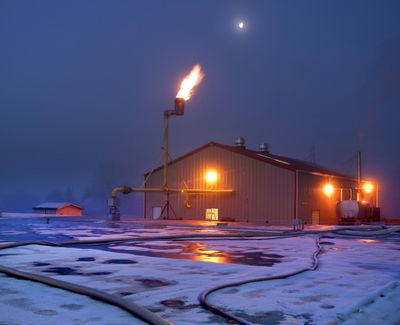Dairies capitalize on cow manure

MONROE, Wash. – It’s 5 a.m. at the Werkhoven Dairy – happy hour for Holsteins.
From a 5,000-gallon black tank containing beer and wine, Andy Werkhoven adds two pounds of alcohol to the feed of each of the 1,000 milking cows.
“Cow-bernet,” he jokes.
The dairy gets alcohol that’s been pulled from store shelves because the expiration dates have passed. The sugar gives the animals extra energy, but the alcohol does not affect the milk.
As dairy farmers everywhere seek to stay in business and meet tougher-than-ever environmental standards, they are finding new ways not only to feed cows, as Andy and his brother Jim Werkhoven have discovered, but to deal with the waste as well – turning manure into money by letting it generate electricity.
Like so many dairy farmers, the Werkhovens felt the pinch in 2008 when milk prices plunged, hay prices rose and there was the ever-present issue of finding appropriate ways to dispose of waste. Right and left, dairies were going under – even those like the Werkhoven Dairy, which has operated for decades.
“I’m just glad my dad wasn’t around to see it,” Andy Werkhoven said. Sam Werkhoven, who started the dairy in 1959 with 25 cows, died several years ago.
When Daryl Williams of the Tulalip Tribes strolled into their pasture one day with an idea on how to turn manure into money, Andy Werkhoven was ready to listen.
The Tulalips were interested because the Werkhoven Dairy is at the confluence of the Skykomish and Snoqualmie rivers, the historic fishing area for the tribe.
Williams’ idea was forming a nonprofit group, Qualco Energy, and buying an anaerobic digester to turn manure into methane, which in turn powers a generator that puts electricity on the grid.
In Washington, there are six digesters. A seventh digester system is being built in Enumclaw. Some serve more than one farm, and while no one has added up the energy they make, they are helping preserve the water quality of rivers for the generations to come, say environmentalists.
“When properly installed, they … provide an overall environmental benefit,” said Larry Altose, spokesman for the Washington Department of Ecology. “The process recovers invaluable nutrients … from the solids left over, and it can be very beneficial to the farm economy.”
Digesters also help control the odor problem from farms and show “great promise” for the dairy industry, Altose said.
Using for energy production bio-waste products that would otherwise have ended up in the sewer or landfill is the dairy trend for the future, said Mark Leader of the Washington Dairy Products Commission.
Washington’s dairies are a $2.3 billion annual industry, when the total economic impact to the state is calculated, and second only to apples in agricultural-product sales, said Blair Thompson, communications director for the Dairy Farmers of Washington.
So important is the dairy industry that last month when ice and snow made highway travel slow and treacherous, Gov. Chris Gregoire waived the limit on driving hours for truck drivers carrying milk from the state’s dairies to processing facilities. She also allowed more driving hours during a 2008 snowstorm because milk spoils quickly.
At Werkhoven Dairy, sales of milk, electricity and compost keep the dairy viable while preserving air and water quality and protecting salmon streams.
The manure from the dairy goes through a complex treatment system, is sent by pipe to the digester about a mile away, and produces enough electricity to power 300 Puget Sound Energy customers.
The Werkhoven Dairy is considered a model of environmental sustainability and, along with George DeRuyter & Sons Dairy in Outlook, Wash., has been nominated for the U.S. Dairy Sustainability Awards to be decided in coming weeks.
The awards are intended to encourage dairies to turn to projects such as the Werkhovens did, Leader said.
In addition to alcohol, the cows also get whey left over from the production of cottage cheese at the Issaquah Darigold plant and flour rejected for human use, eggs past their expiration date, leftover brewers’ grain and the usual mix of corn sileage, alfalfa and molasses, Werkhoven said.
The “leftovers” are an economical feed that’s also good for the cows.
Before the dairy took them, the leftovers went down the sewer or into a landfill. Now the cows are recycling them – the dairy diet is designed by a nutritionist who visits weekly. And what the cows don’t eat goes into the digester, operated by Qualco but connected to the farm by underground pipes that carry the separated waste products from the dairy to the plant.
The plan for the dairy’s transformation actually started a few years ago when Monroe beef farmer Dale Reiner launched a project to restore the Haskell Slough, which over the years had filled, and trapped salmon in the dry months. He eventually was joined by Northwest Chinook Recovery (an organization working to restore salmon habitat), and the Tulalip Tribes.
Williams got the tribes to invest $150,000, convincing members that where the site was concerned “cows were better than condos.” The U.S. Department of Energy came up with a $250,000 grant and the Department of Agriculture gave $500,000. The Werkhovens put up $150,000. Qualco Energy was formed and now brings in $25,000 a month from the energy it creates.
The Legislature agreed to turn what long ago had been a minimum-security prison “honor farm” over to the Tulalip Tribes for the project.
The process of transforming the manure takes place underground, so there’s no odor, Werkhoven said.